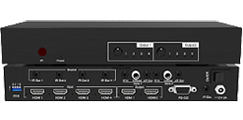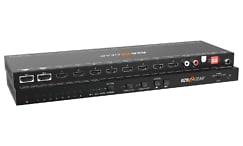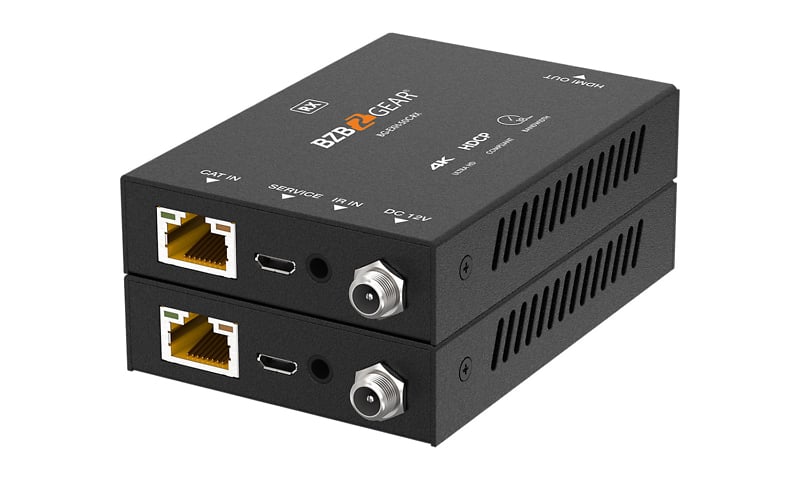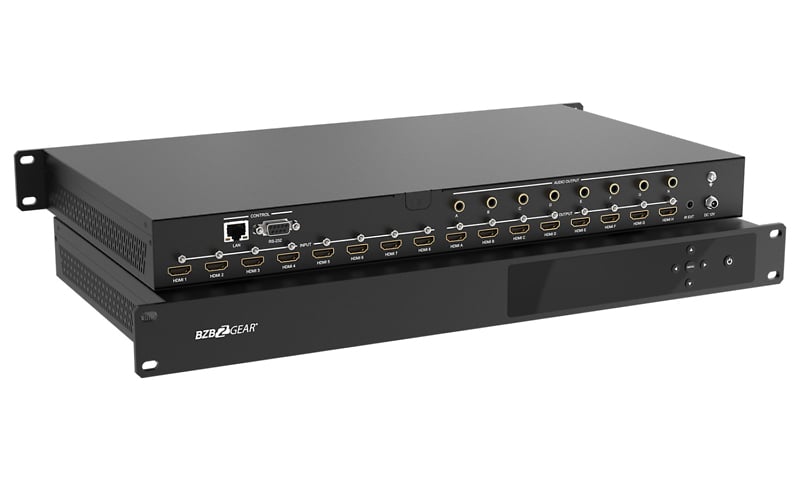What Is a Video Processor and How to Set Up a System?

A video processor converts video input signals into viewable content. The video sources being converted are usually HDMI, DVI, or VGA signals from cable boxes, media players, or computers. These signals are then converted for displaying on TVs or projectors. The term “video processor” covers a variety of devices including matrix switchers, amplifiers/splitters, multiviewers, video walls, and presentation switchers.
Matrix Switcher

Matrix switchers are the most commonly utilized device in both commercial and residential environments. They are capable of delivering 4K and 1080p video from multiple sources to multiple displays. These types of switchers typically scale resolutions and support audio like digital coax, SPDIF, and analog RCA. Common places for a matrix switcher would be a sports bar, mall, or anywhere visual imagery can make an impact.
Amplifier/Splitter

Amplifiers/splitters split and distribute a single video signal to multiple displays. They basically duplicate the same image across all displays. Amplifiers/splitters are used in many malls, retail shops, and transportation facilities for advertising and digital signage. These devices can also be combined with matrix switchers to save costs since matrix switchers are more expensive when more than eight TV displays are required.
Multiviewer

Multviewers are the solution if the application requires a video processor to show multiple sources on a single display. Multiviewers typically have two to six HDMI input connections and one HDMI output for the display. These devices are found in places like business conference rooms, entertainment venues, schools, and restaurants.
Video Wall Processor

Video wall processors usually accept one source signal for the purpose of displaying it on four displays and combined to make one large screen. For entertainment purposes, there are many types of configurations and layouts: 2x2, 3x3, and 4x4. But for digital signage, where rotating the images on the displays either vertical and horizontal is needed, most video wall processors will also support layouts like 1x2, 1x3, 2x1, 3x1, and 4x1. These devices are used in airports, healthcare facilities, business offices, sports bars, malls, schools, and residential homes.
Presentation Switcher

Presentation switchers are perfect for conference rooms and displaying material transmitted from employees' computers computers. These devices typically have HDMI and wireless connections using tech like Miracast and Airplay to simplify connectivity. Some presentation switchers offer USB 2.0/3.0, USB-C, DisplayPort, and even VGA connections for hosting a variety of devices.
How to Set Up a Video Processor System
THE SCENARIO

The owner of a pool hall, Dave, wants to attract more customers by adding four more TVs to his establishment. He already has four displays connected with cable boxes mounted to the top of them. Dave wants to consolidate and place all the AV equipment in a closet so they can be in one location. The four new TVs will be about 100 feet away while the current four TVs are about 30 feet in distance on the other side of the wall. Dave also has a pair of ceiling speakers and wants to add a new audio amplifier to the speakers for one source.
THE SOLUTION
For this scenario, we will use an 8x8 HDMI matrix switcher. The BG-UM-88ANS is an eight-input / eight-output HDMI matrix switch that distributes the signals of up to eight sources to eight displays. Connect the four current TVs using 40 ft HDMI cables from the matrix switcher’s HDMI outputs. The new TVs located 100 ft away requires HDMI extenders over CAT6 cabling since HDMI cables only reach about 50 ft.
We’ll install four HDMI extenders (BG-EXH-50C) by connecting the four transmitters to the matrix switcher’s HDMI outputs. Mount the four receivers behind each of the displays. Run CAT6 cables to the TVs from the AV equipment location. Connect the CAT6 cables to the receivers and transmitters. Connect the TVs to the receivers using HDMI cables.

For audio, we’ll connect an audio amplifier (BG-AMP2X20) to the 3.5 mm analog audio port of the source. We’ll then need to set up the matrix switcher’s audio to follow the source video. Connect the ceiling speakers to the audio amplifier and we are set. Power up all the devices and Dave is ready to rock. To control the entire system, Dave can use the included IR remote control, Web UI, or a third-party control system via the RS232 connections.


For more information, contact BZBGEAR at 1.888.499.9906 or email info@bzbgear.com. Browse our online catalog for Pro AV and live streaming camera solutions to fit any size application or budget. Make sure to catch the buzz on BZB TV for unboxings, demos, and How To videos. And please show your support by subscribing! We appreciate you and will keep you informed on all the latest AV gear.
8.00 a.m. - 5.00 p.m. (PST)
10.00 a.m. - 3.00 p.m. (PST)
(by appointment only)



